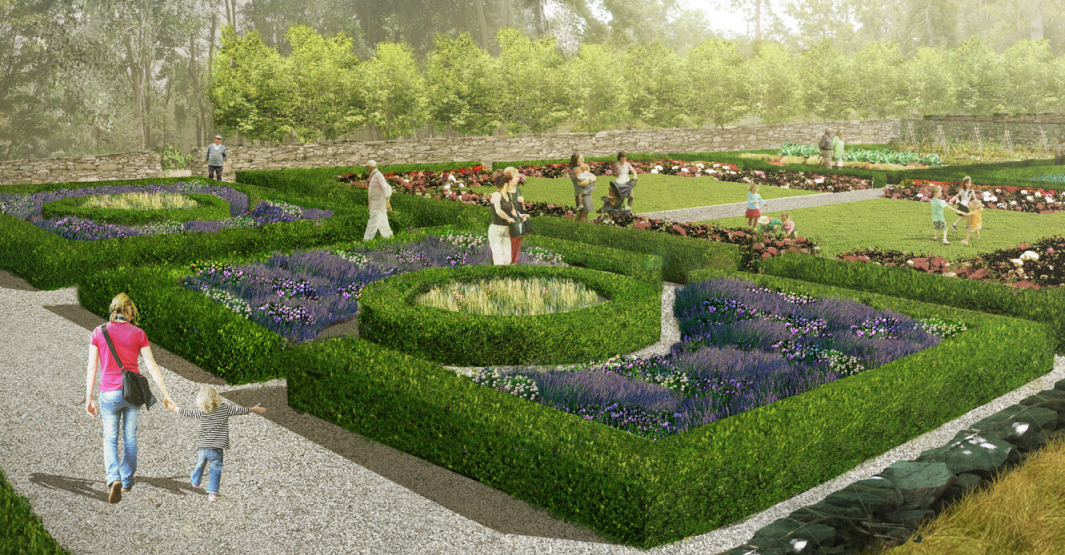
(Updated) RYE, New York, August 23, 2021 — The Covid-19 pandemic may have stalled capital projects at many museums, historic sites, and parks—but not at the Jay Estate, the 23-acre National Historic Landmark in Rye, New York. Last summer the site broke ground on a major garden project that will continue the reclamation and restoration of its historic landscape. Overlooking Long Island Sound, the property was once the land of the Lenape before it became the family seat of nation-maker John Jay, who helped abolish slavery in New York State. Today the Jay Estate is a home for ideas, civil dialogue, and action about social and environmental justice and much more. Operated by the nonprofit Jay Heritage Center (JHC) for the benefit of the public, the land—particularly its stunning viewshed—gives context to the stories of its diverse inhabitants and stewards going back thousands of years.
During the past decade, the Center has focused not only on its buildings but also on the surrounding grounds that had suffered from neglect and intrusions. A key element in this program has been the restoration and reimagining of the gardens, which occupy more than two acres. A $500,000 grant from the New York State Regional Economic Development Council (REDC) was matched with more than $850,000 by JHC in private and foundation monies. The multi-year planning process involved a successful collaboration and underscores the benefits of advocacy and dynamic public-private partnerships. In 2013, JHC was awarded stewardship of the property, which is owned jointly by JHC, New York State Parks, and Westchester County Parks. JHC has been making enormous strides in revitalizing the site ever since.
JHC chose award-winning landscape designers Nelson Byrd Woltz (NBW) to design and oversee the garden project based on their significant experience in planning cultural landscapes. Their ecologically sustainable projects have been varied and include restoring the viewshed of Olana, home of the renowned nineteenth-century painter Frederic Edwin Church near Hudson, New York. Among other credits is their design for a pollinator pathway and meadow at the Brooklyn Naval Cemetery that memorializes the unknown soldiers interred there.
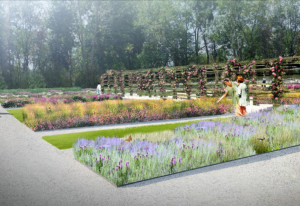
For the Jay Estate, Thomas Woltz and his team, including Mark Strieter and Charlotte Barrows, created a dynamic plan that underscores the cultural history of this site at a time when discussions of the relationship of race and land and public access to fresh air and green space are long overdue. Preservation of critical built heritage features will illuminate the daily lives of the varied inhabitants, including the Valentine Family – enslaved and freed women and men of African descent known to have lived, worked, and been buried at the Jay property. Protecting the site’s natural heritage is of paramount importance, too. The plan increases biodiversity by replacing invasive species like mugwort, Japanese knotweed and porcelain berry with beneficial native shrubs and plants like red twig dogwood, arrowwood viburnum and American pillar rose to name just a few.
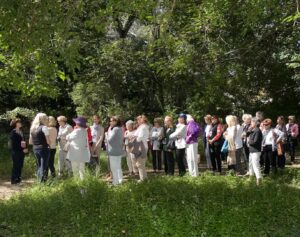
Based on years of consensus building with the community, NBW’s garden design is informed by a trove of period photos, drawings, and other documentation. The project has included extensive archaeological excavations. Bits of First Peoples pottery, historic ash paths, animal bones, cisterns, and even the foundation and chimney of a colonial-era dwelling have been unearthed and mark the daily footsteps of real people from the seventeenth to the twentieth centuries. The extended planning process included an award-winning 2002 Cultural Landscape Report by Patricia O’Donnell of Heritage Landscapes. That report underscored the narratives of the land and its varied uses which informed the NBW design.
While the gardens date back to the 1700s or earlier, the revitalized space will not be a “period” recreation but rather a richly interpreted rehabilitation. Lost visual and spatial relationships will be reestablished. Three existing stone-walled rooms will contain largely native and drought-resistant species in response to climate change. The innovative schematics include a picturesque parterre; an outdoor classroom and hands-on planting area with 16 rotating vegetable beds; a reflecting pool and sensory garden; and a 100-foot-long rose arbor and pollinator pathway. “As landscape architects, we have always known the importance of public space,” said Woltz. “And right now, the opportunity to breathe new life into an outdoor space of this historic importance feels that much more essential.”
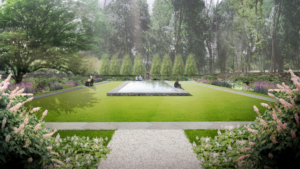
“The refreshed gardens will provide much-needed outdoor classrooms to expand our collaborative efforts with area partners while they will also enhance our existing history and conservation curriculum,” said Suzanne Clary, president of the Board of Trustees of JHC. A virtual program about preserving Black history with Brent Leggs, executive director of the African American Cultural Heritage Action Fund of the National Trust for Historic Preservation, is just one example of the types of topics and speakers regularly hosted at the Jay Estate. Past speakers have included climate writer Tatiana Schlossberg, entomologist and wildlife ecologist Doug Tallamy, environmental journalist Andrew Revkin, and landscape ecologist Eric Sanderson.
Phase I of the new gardens is slated to be completed by Spring 2022.
Learn more about other projects by Nelson Byrd Woltz here with this video “Listening to Land” produced jointly by Institute for Classical American Architecture (ICAA) and Classical American Homes Trust
# # #
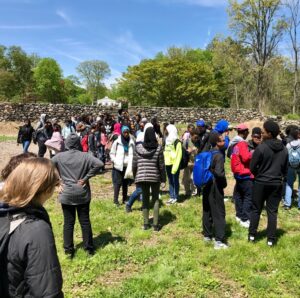
About The Jay Heritage Center
The nonprofit Jay Heritage Center (JHC) is dedicated to preserving, protecting, and revitalizing a place that has meaning for all Americans: The Jay Estate. The property is the centerpiece of the National Historic Landmark Boston Post Road Historic District, an irreplaceable cultural and natural resource. Through lectures, workshops, volunteer opportunities, school programs, and concerts, JHC offers timely lessons in history, environmental conservation, architecture, and social justice, while tracing the evolution of democracy in the United States. It hopes to inspire the future historians, civic advocates, and stewards of our fragile cultural and natural resources. Just as the architects of our nation’s government pursued self-improvement through dialogue about our nation’s most relevant topics, JHC promotes learning through programs led by prominent experts, Pulitzer Prize-winning authors, and academics in a variety of disciplines from sustainability to legal history. Over the past 30 years, JHC has formed lasting partnerships with other institutions to expand the impact of its work. It is a proud member of NY State’s Path Through History, the Hudson River Valley National Heritage Area, and Westchester County’s African American Heritage Trail. It has been a recipient of prestigious grants and awards from the Save America’s Treasures program, the NY Regional Environmental Development Council, and the Garden Club of America.
About Nelson Byrd Woltz
Nelson Byrd Woltz is an internationally recognized landscape architecture firm with studios in New York City, Charlottesville, VA, Melbourne, Australia and Houston, TX. The firm has been instrumental in steering landscape architecture towards integrated, ecologically performative design, relying on science-based methodology and collaboration with a wide range of systems-experts. NBW has dramatically expanded the traditional role of landscape architecture into the areas of restoration ecology, urban planning, civil engineering, and agriculture. In the past five years NBW has been entrusted with the design of significant public parks and cultural institutions in the United States, Canada, and New Zealand, placing 20 years of construction and design innovation in greater service to the public realm. The firm has worked in 25 states and 11 countries and garnered over 100 awards within the past 15 years, including the prestigious Amanda Burden Public Open Space Award for Citygarden in St. Louis, MO. In addition to Memorial Park, current projects include Hudson Yards Plaza and the Flight 93 National Memorial (PA), Google Corporate Headquarters (CA), Catalina Island (CA), Devonian Botanic Garden (Edmonton, Canada), Southwest Waterfront (Washington, DC) and Brooklyn Navy Yard Naval Hospital Cemetery Memorial Landscape (NY). The work of the firm has been featured in numerous national and international publications and is the subject of a monograph published by Princeton Architectural Press.
